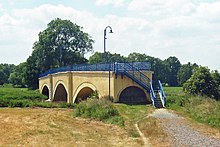Canitz waterworks
The Canitz waterworks is the largest of the waterworks operated by the Leipzig municipal waterworks . It supplies around a third of the amount of water made available in the city of Leipzig .
Location and description
The waterworks is located on the right side of the Mulde about three kilometers northwest of Wurzen in the village of Canitz , which has been part of the Thallwitz community since 1963 . The distance to the south-west of Leipzig is about 23 kilometers.
In a narrow strip of land over four kilometers long, roughly parallel and a few hundred meters away from the hollow, there are around 255 wells with depths between 10 and 16 meters. The water, after the siphoning principle led into a collection well, and after aeration in a closed monolayer Riesleranlage in twelve gravel filter passed to it turbidity , carbonic acid , iron and manganese escape. The remaining de-acidification takes place by dosage of sodium hydroxide , as a disinfectant is chlorine gas supplied. The capacity of the plant is 38,000 cubic meters per day and the annual output is around eleven million cubic meters. The main building, which essentially contains the pumps, is a listed Art Nouveau building .
The treated drinking water reaches the Leipzig- Probstheida water supply system via a 23-kilometer underground pipeline . A certain specialty is the crossing of the hollow. The pipes run within a 125 meter long three-span concrete arch bridge with plaster structure. Side stairs enable pedestrians to enter. Built as a road bridge, its use as such failed due to the approval of the Canitzer landowner at the time for the construction of the access ramps. And so it has remained with the staircases to this day. By Canitz and near Waterworks and bridge (but not over it) runs the dump cycle path , on the other side are hollow village and castle Püchau .
To protect the drinking water resources in the Thallwitz district of Wasewitz, Wassergut Canitz GmbH, a subsidiary of Wasserwerke Leipzig, operates organic farming on 750 hectares in the drinking water catchment area without the use of chemical-synthetic fertilizers.
history
With the increase in Leipzig's population towards the end of the 19th century, the capacity of the waterworks near Naunhof that had supplied the city up to that point was no longer sufficient. After extensive hydrological investigations, the hydraulic engineer Adolf Thiem (1836–1908), who had also planned the Naunhofer waterworks, planned the Canitz waterworks in the Muldenaue, which was built from 1907 to 1912.
From 1912 to 1926 the waterworks operated with steam-driven piston pumps . These were replaced in 1927 by electrically operated pumps and the forge that had been necessary up until then was removed. After 1990 the technology was renewed.
The Canitz water estate was created in 1994 from the municipal council estate founded in 1907, which after 1945 was run together with the estate in Sommerfeld as a people's own estate (VEG).
Thallwitz plant
To further increase capacity, the Thallwitz waterworks was built between 1936 and 1943 about three kilometers northwest of the Canitzer plant in the Kollau district of Thallwitz. Mainly bank filtrate is extracted here in around 140 wells . It is processed as similar Canitzer work, except that the ventilation is carried out by spraying instead of trickling and additionally polyaluminum as a flocculant is added.
The maximum daily output is 25,000 m³, and the annual output is six million cubic meters. The pipeline to the Leipzig-Probstheida container facility runs parallel to that of the Canitzer plant.
Web links
- Our waterworks. In: Flyer of the municipal waterworks Leipzig. Retrieved February 27, 2018 .
- Wassergut Canitz - good water since 1907. In: Flyer of the municipal waterworks Leipzig. Retrieved February 27, 2018 .
Individual evidence
- ^ Canitz in the Digital Historical Directory of Saxony
- ↑ Our waterworks. Retrieved February 27, 2018 .
- ↑ List of cultural monuments in Thallwitz (ID number 08972262)
- ↑ Mulderadweg. Retrieved June 21, 2020 .
- ^ Wassergut Canitz GmbH. Retrieved February 27, 2018 .
- ↑ 2. On the history of the Friends of the Middle Muldegebiet eV, p. 7. Accessed on February 28, 2018 .
Coordinates: 51 ° 24 ′ 26 " N , 12 ° 41 ′ 9" E


